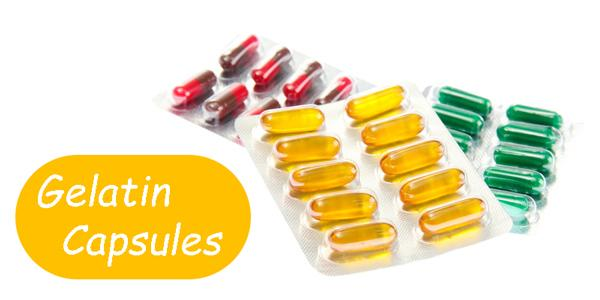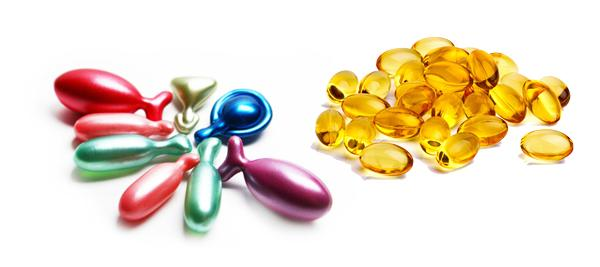Capsules, widely recognized for delivering medication, consist of an outer shell that contains therapeutic substances inside. There are primarily 2-types, soft gelatin capsules (soft gels) and hard gelatin capsules (Hard gels)—both of these can be used for liquid or powdered medications, offering a convenient and effective means of treatment.

Figure no 1 Soft Vs. Hard Gelatin Capsules
-
- Today, capsules account for over 18% of the pharmaceutical and supplement market. The 2020 Natural Marketing Institute study revealed that 42% of consumers, especially supplement users, prefer capsules. The global demand for empty capsules will reach $2.48 billion in 2022, projected to reach $4.32 billion by 2029. Understanding the differences between soft and hard gelatin capsules is essential for enhancing medical care as the pharmaceutical industry develops.
In this article, we will explore soft and hard gelatin capsules, providing you with a comprehensive understanding of their characteristics and distinctions.
- Today, capsules account for over 18% of the pharmaceutical and supplement market. The 2020 Natural Marketing Institute study revealed that 42% of consumers, especially supplement users, prefer capsules. The global demand for empty capsules will reach $2.48 billion in 2022, projected to reach $4.32 billion by 2029. Understanding the differences between soft and hard gelatin capsules is essential for enhancing medical care as the pharmaceutical industry develops.
➔ Checklist
- What's a Gelatin Capsule?
- What are Soft & hard Gelatin Capsules?
- Pros & Cons of Soft and Hard Gelatin Capsules?
- How soft & hard Gelatin Capsules are made?
- Conclusion
“As you already know that a Capsule is basically a container used for medicine delivery, and as the name suggests, Gelatin Capsules are a kind of capsules that are made from Gelatin.”

Figure no 2 Gelatin Capsules of different kinds
Gelatin Capsules offer an efficient way to take medicines or supplements. They protect the contents from air, moisture, and light, preserving their effectiveness which is crucial in the pharmaceutical and supplement industries. Gelatin capsules are also easy to use and can hide unpleasant tastes or smells.
Gelatin capsules are usually colorless or white but can also come in different colors. And to make these capsules, molds are dipped in a gelatin and water mixture. The coated molds are rotated to create a thin gelatin layer inside. After drying, the capsules are taken out of the molds.
2) What are Soft & hard Gelatin Capsules?
There are two main types kinds of Gelatin capsules;
i) Soft gelatin capsules ( Soft gels )
ii) Hard gelatin capsules ( Hard gels )
i) Soft Gelatin Capsules (Soft gels)
“Smell raw collagen in powder form, and then smell it after mixing it with water.”
+ Good-quality collagen should have a natural and neutral scent before and after making its water solution.
- If you notice any strange, firm, or unpleasant odors, it could be a sign that the collagen might not be of the best quality or isn’t pure.
Softgels are commonly used for substances sensitive to moisture or oxygen, as the sealed shell helps protect the enclosed material from degradation. They are known for their easy digestibility and can mask any unpleasant taste or odor.

Figure no 3 Softgels seamless Gelatin capsules transparent and colorful
ii) Hard Gelatin Capsules (Hard Gels)

Figure no 4 Hardgel Gelatin capsules
“Hard gelatin capsules, also known as hard gels, have a more rigid shell compared to soft gels.”
These capsules are typically used for containing dry powders, granules, or other solid forms of medication or supplements. The outer shell of a hard gelatin capsule is designed to hold its shape even under pressure.
When ingested, the shell may take a bit longer to dissolve in the stomach, allowing for a controlled release of the enclosed substance. Hard gels are often used when the substance to be encapsulated is stable in a dry form or when immediate release is not required.
3) Pros & Cons of Soft & Hard Gelatin Capsules
Both Softgels and Hardgels capsules are famous in the medical and pharmaceutical industry, but each one has its own uses, pros, and cons, such as;
i) Softgels Capsules Properties
ii) Hardgels Capsules Properties
i) Softgels Capsules Properties
➔ Pros of Softgels
+ Easy to swallow due to flexibility.
+ Ideal for liquid, oily, and powdered substances.
+ Effective in masking unpleasant tastes or odors.
+ Rapid dissolution in the stomach for quick absorption.
+ Offers protection against moisture-sensitive materials.
➔ Cons of Softgels
- Potentially higher manufacturing costs
- Not as durable as hard gelatin capsules
- Slightly less stable in high temperatures.
- Limited in terms of controlled release options.
- It may not be suitable for dry or solid substances.
ii) Hardgels Capsules Properties
➔ Pros of Hardgels
+ More stable in high temperatures.
+ Generally lower manufacturing costs.
+ Well-suited for stable, dry formulations
+ More durable than soft gelatin capsules
+ Controlled release for gradual absorption.
+ It can hold dry powders, granules, and solids effectively.
➔ Cons of Softgels
- Slower dissolution in the stomach
- Limited use for liquid or oily substances
- Less flexible and slightly harder to swallow
- Reduced protection for moisture-sensitive materials
- It may not effectively mask unpleasant tastes or odors
➔ Table Comparison - Softgels Vs. Hardgels
The following is the comparison between soft and hard gelatin capsules;
|
Soft Gelatin Capsules |
Hard Gelatin Capsules
|
|
| Flexibility |
|
|
| Release |
|
|
| Use Cases |
|
|
| Absorption |
|
|
| Dissolution |
|
|
| Protectiveness |
|
|
| Odor/Taste Masking |
|
|
| Example Applications |
|
4) How soft and hard gelatin capsules are made?
Capsules manufacturers around the world use these basic methods to make their soft and hard gelatin capsules;
i) Manufacturing of Soft Gelatin Capsules (Softgels)
Step no 1) The ingredients used to make a gelatin solution include gelatin, water, plasticizers, and occasionally preservatives.
Step no 2) The gelatin sheet passes through two rolling molds, which cut out, a capsules-like casing from this sheet.
Step no 3) The capsule shells move to a filling machine where the liquid or powdered contents are accurately dispensed into each shell.
Step no 4) The capsule shells are sealed by applying heat or ultrasonic welding to the edges, ensuring the contents are securely enclosed.
Step no 5) The sealed capsules are dried to remove excess moisture and solidify the gelatin shell.
Step no 6) The gelatin shell of the sealed capsules is solidified by drying them to remove excess moisture.
ii) Manufacturing of Hard Gelatin Capsules (Hard Gels)
Step no 1) Similar to soft gels, a gelatin solution is prepared by mixing gelatin and water.
Step no 2) Then, pin-like molds are dipped into a gelatin solution, and when these molds are taken out, a thin capsules-like layer is formed on their surface.
Step no 3) Then these pins are spun to form a balance layer, then they are dried so the gelatin can harden.
Step no 4) The capsule's half-shells are stripped out from the pins and cut to the desired length.
Step no 5) The top and bottom halves are joined, and the capsule is locked by pressing them together.
Step no 6) Capsules are polished to improve appearance and undergo thorough inspection for quality assurance.
Step no 7) These capsules go to empty capsules suppliers or directly to the medicine companies, and they fill their bottom with the desired substance, often dry powders or granules.
5) Conclusion
Now that you're familiar with the characteristics and distinctions of both soft and hard gelatin capsules, you can confidently pick the one that best suits your demands. While both types hold equal importance and serve similar purposes, your choice can be tailored to your preferences.
At Yasin, we offer a comprehensive range of soft and hard gel capsules designed to cater to your requirements while ensuring minimal impact on your stomach and wallet. Our commitment to providing both gelatin and vegetarian capsule options - ensuring your well-being remains our priority.
Post time: Aug-21-2023






